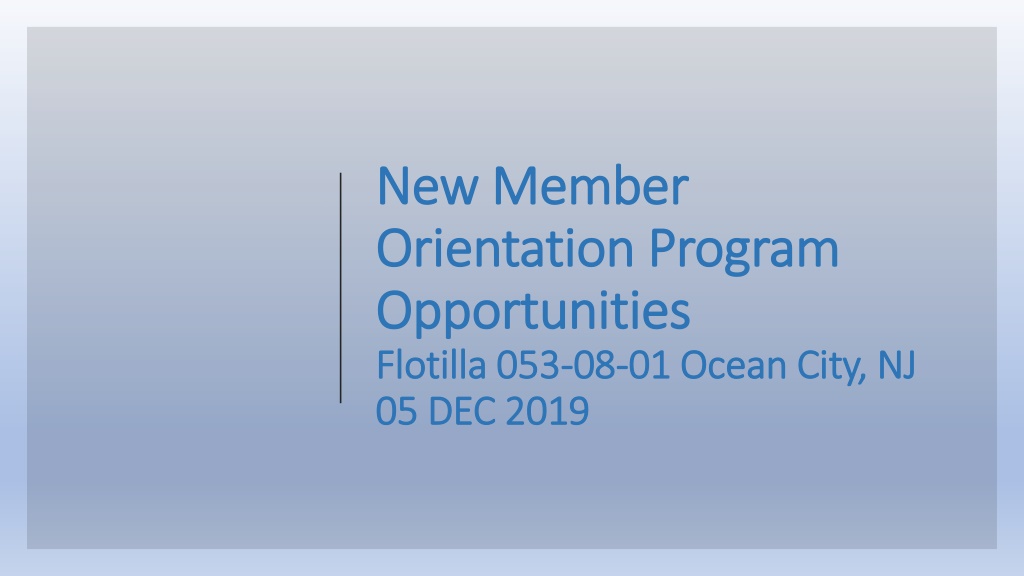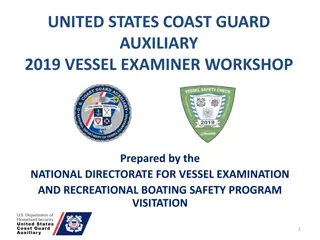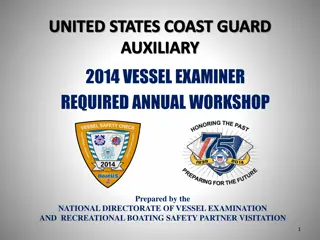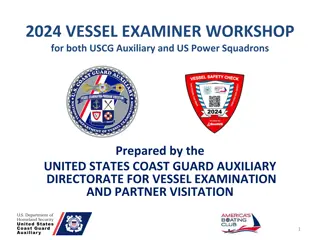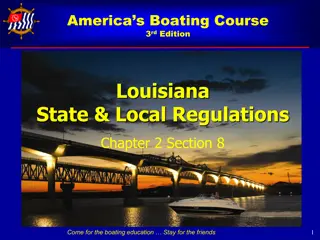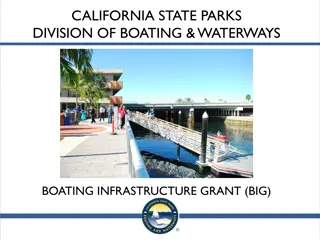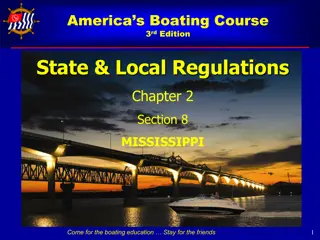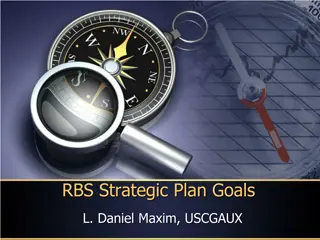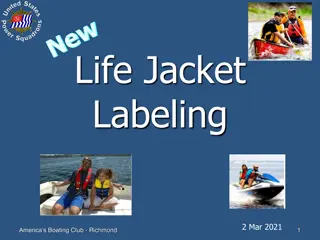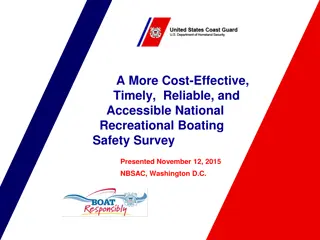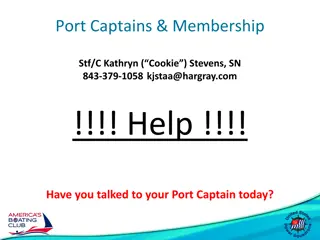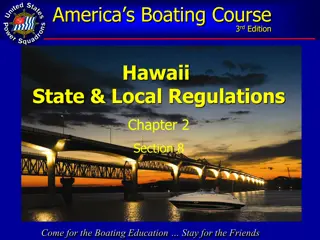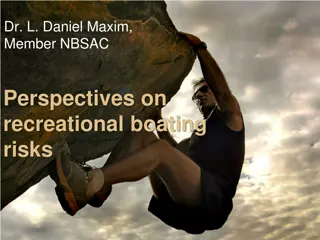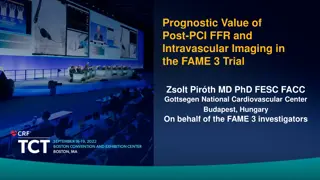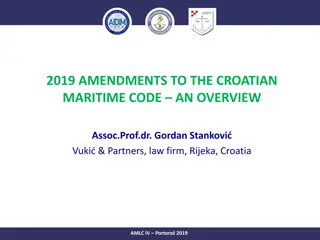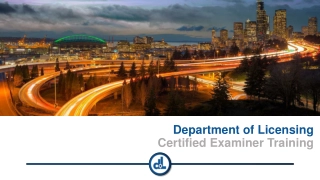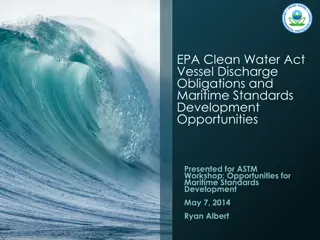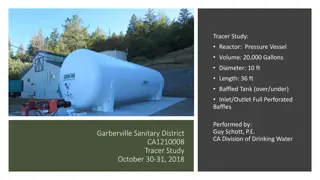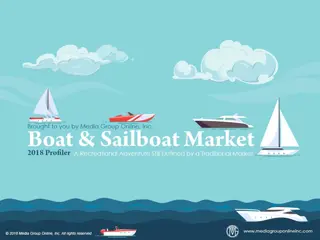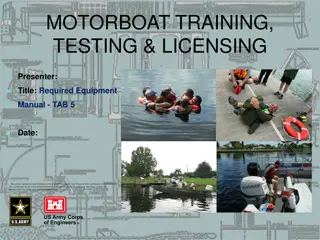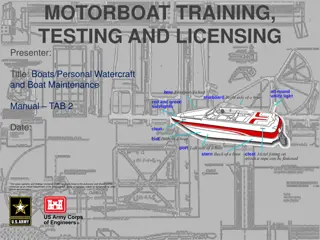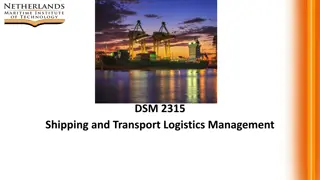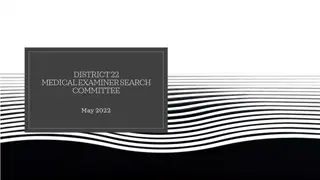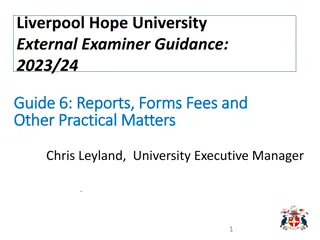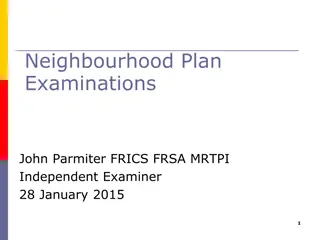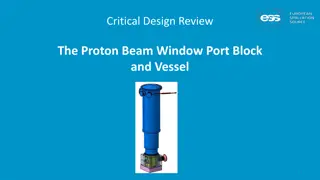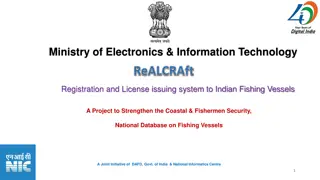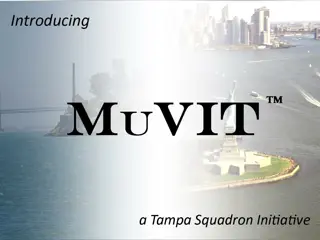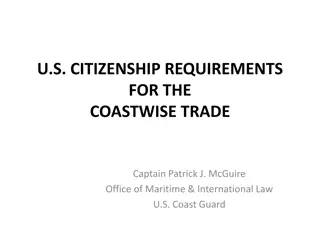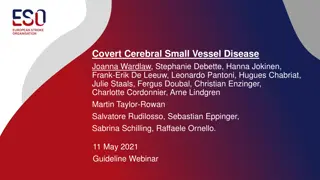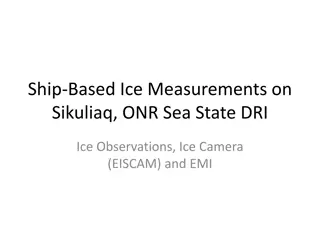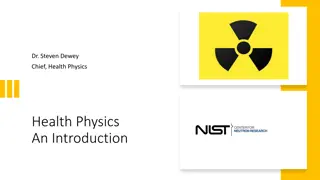Enhancing Boating Safety Through Vessel Examiner Training Programs
Engage in boating safety with the public by becoming a Vessel Examiner (VE) and conducting Vessel Safety Checks (VSC). Learn how to ensure recreational vessels meet legal safety requirements and raise boater awareness. The process includes VSCs, Vessel Registration, VE qualifications, and participating in the Recreational Boating Safety Program Visitor mission.
Download Presentation

Please find below an Image/Link to download the presentation.
The content on the website is provided AS IS for your information and personal use only. It may not be sold, licensed, or shared on other websites without obtaining consent from the author. Download presentation by click this link. If you encounter any issues during the download, it is possible that the publisher has removed the file from their server.
E N D
Presentation Transcript
New Member New Member Orientation Program Orientation Program Opportunities Opportunities Flotilla 053 Flotilla 053- -08 08- -01 Ocean City, NJ 01 Ocean City, NJ 05 DEC 2019 05 DEC 2019
Agenda Agenda YEAR 1 Suggestions YEAR 2 Suggestions Vessel Examination Program Visitation Boat Crew Aids to Navigation Verifier Offer facility for use Instructor Coxswain AUXOP OTHER TOPICS How to find resources and training related information Preparing a 7029 Form How to track your training status
Becoming a Vessel Examiner (VE) is one of the most common and effective way to engage in boating safety with the public. The public can access Vessel Safety Checks (VSC) through a variety of sources: Scheduled events held at local marinas Through our Flotilla contact number Through the I want a VSC website Friends and family A VE ensures that recreational vessels meet legal requirements for for safety through a VSC and awards the owner a VSC decal if they meet all mandated requirements. Raises boater s awareness of safety issues through one-on- one contact with the Vessel Examiner. Vessel Vessel Examinations Examinations - - Mission Mission
Vessel Registration & boat numbering Life Jackets, Throw Cushions, Fire Extinguishers, Flares Navigation Lights, Sound Producing Devices Marine Sanitation Devices & Pollution Placards Compliance with additional state and local requirements Overall vessel condition Vessel Vessel Examinations Examinations Areas Inspected Inspected Areas
Study the Vessel Safety Check Manual and/or take the optional online course on the Coast Guard Auxiliary Online Classroom. Take a non-proctored open book VE exam at the National Testing Center website, completing the exam within 3 hours with a score of 90%. Become BQ Qualified Satisfactorily complete 5 VSC s under the supervision of a qualified Vessel Examiner. Awarded the Examiner Ribbon Vessel Vessel Examinations Examinations - - Qualifications Qualifications
The Recreational Boating Safety Program Visitor (RBSVP) mission involves making periodic visits to places where boaters may be exposed to boating safety literature. The Program Visitor becomes a point of contact and source of information at boating supply stores, marinas and other places where boaters may be contacted. These visits are an ideal way to promote our boating safety classes, membership in the Auxiliary, and boating safety in general. Program Program Visitor Visitor - - Mission Mission
Establish/enhance working relationships between partners, the Coast Guard and Program Visitors Use the partner as a contact point for making the boating public aware of federal, state and local boating safety requirements Provide information regarding public boating safety education programs, Vessel Safety Checks, and membership in the Auxiliary Distribute federal, state and local safety materials Provide the partner with a resource person for boating safety issues Assist in NOAA Small Craft Marina Facility updating. Program Program Visitor Visitor - - Activities Activities
BQ Qualified Familiar with the Vessel Safety Check Program To become a PV, you should take the RBSVP online classroom training class. There are complete instructions, and online manuals to use and complete the class online. Take an online test through the National Test Center (MDV) After successfully completing the online course, the member must complete 2 supervised visits with any currently certified PV. Four additional visits are not required but recommended for the year. To remain current, the member must complete a minimum of four visits each year. Program Program Visitor Visitor Qualifications Qualifications & Currency & Currency
Surface Operations include three positions: Crew; Coxswain, PWC Operator Qualified Crew participate in a wide variety of missions. Routine safety patrols (MOM) Regatta support (e.g. Night in Venice) Safety zone support (e.g. Atlantic City Air Show) Exercise support (e.g. training evolutions) Search & Rescue Aids to Navigation You are functioning as the Coast Guard. It is not enough to know how to operate a boat. YOU MUST DO IT THE COAST GUARD WAY. Requires greater thoroughness in planning, seamanship and coordination. Surface Surface Operations Operations - - Missions Missions
BQ Qualified passed approved Boating Safety Training class and all mandatory training Physically able to perform required tasks Pass swim test Complete FEMA courses ICS 100 (An Introduction to Incident Command System ICS 700 ( National Incident Management System (NIMS), An Introduction Complete 4-hour Team Coordination Training Complete Introduction to Risk Management Course via AUXLMS Log 12 hours underway as a trainee Surface Surface Operations Operations Crew Crew Qualification Qualification Requirements Requirements
Qualification tasks define the required knowledge/skills for the surface crew position The Auxiliary Boat Crew Qualification Guide (Volume 1: Crew Member) provides an inventory of all the tasks that must be completed by the trainee. Crew Efficiency Factors and Team Coordination First Aid and Survival Marlinspike Seamanship and Boat Nomenclature Boat Handling & Navigation Communications Mission Oriented Operations/Auxiliary Specific Tasks The Boat Crew Seamanship Manual documents basic principles and subject matter areas that form a firm background of seamanship. Providing the most efficient methods, techniques, and information guidance for boat crews. Surface Surface Operations Operations Qualification Qualification Tasks Tasks
Trainees are assigned a mentor. When the trainee demonstrates mastery of the tasks without guidance, the task is signed off by the mentor. Once all qualification tasks have been signed off, the trainee than completes a dockside oral examination and an underway check ride with a Qualification Examiner (QE). The QE submits a recommendation to DIRAUX who certifies that the trainee has met all requirements. Once the member is certified by DIRAUX, they will receive a ribbon and assigned on patrols as crew . Surface Surface Operations Operations - - Certifications Certifications
Surface Operations Surface Operations - - Currency Requirements Currency Requirements The member maintains currency of certification by meeting annual minimum standards. 1-hour TCT refresher course Operations Workshop, when required 12 hours underway Every three years, under the direction and evaluation of a QE, the crew member, must answer questions and demonstrate proficiency in a series of evolutions, including: Participate in a pre-briefing Use of personnel survival equipment Line handling/knot tying Helm and lookout watch Man Overboard drill Stern and side towing Anchoring and docking Every five years, the member must complete a 4-hour TCT course.
Take FEMA ICS Courses 100 & 700 (JAN MAR) Begin studying the Seamanship Crew Manual and Qualification Guide (JAN-MAR) Surface Boating Safety Class - attend either the 23 Mar or 27 APR class if needed Operations - Boat Crew Training Timeline for 2020 4-Hour Team Coordination Class (tentative MAR timeframe) Crew Training Course (4 sessions to be tentatively scheduled for FEB to MAR) Swim Test (MAR-MAY timeframe) Assignment of Mentors (FEB) Obtain sign-off from mentor on all required qualification tasks (MAR to JUN) On-water training (MAY-JUL) Dockside Oral Examination and Underway Check Ride (JUN-JUL)
. Support and augment the Coast Guard s navigation systems (NS) program. Verify position and characteristics of private aids-to-navigation (PATON), after qualifying May assist and support aids-to-navigation (ATON) units in servicing Federal aids after receiving proper Coast Guard training. AUX may also help the National Oceanic and Atmospheric Administration (NOAA) and the U.S. Army Corps of Engineers (USACOE) by updating nautical and aeronautical charts and publications, by supporting and augmenting bridge surveys, by investigating incidents and by providing information regarding waterways safety and navigation situations pertaining to the bridge program and providing direct assistance and support to bridge program personnel. ATON Verifier ATON Verifier - - Mission Mission
Charts & Nautical Publications US Aids to Navigation (ATON) Private Aids to Navigation (PATON) Aid to Navigation Discrepancies PATON Documentation ATON Bridge Verification PATON Certification and Currency Maintenance ATON Verifier ATON Verifier - - Activities Activities
Prior experience is not required Complete 4-hour TCT course Complete ICS 100 and ICS 700 BQ Qualified Three-hour course Buoy identification, function, position, lighting Bridge identification and lighting issues Issue Reporting Complete PQS (A qualified AV observes your successful performance of each task without prompting or references) Daylight buoy and bridge analysis Dark buoy and bridge analysis ATON Verifier ATON Verifier - - Qualifications Qualifications
Four Types of Facilities - Auxiliarist Owned; Government Owned; Corporate Owned; Partial Auxiliarist Owned Corporate and Partial Auxiliarist Owned Vessels can be accepted after considering several factors such as verification of ownership, registration, proper authorization from non-Auxiliarist owner No vessel used in towing, salvage or marine police work can be accepted Facility Inspection and Offer for Use form must be properly prepared; facility must be inspection by a qualified Vessel Examiner; and the offer for use approved by the Director Offering of Facility for Use
If the owner is not the operator, they must document the specific individuals or groups of individuals who may operate the vessel and whether the owner must be on board. The facility must have a proper Offer for Use form and current inspection on file and the coxswain must be properly authorized for operation of that facility before Coast Guard orders are issued. Specific equipment is required to be on board. These include items such as communications, towing, search and rescue, safety, identification placards/ensigns, etc Use of Facility
Promote Recreational Boating Safety by providing excellent boating safety education with the aim of reducing the loss of life, personal injury and property damage 81% of deaths occur on boats where the operator had not received the proper boating safety instruction 80% of those that drown were not wearing a life jacket Top 5 reasons for deaths include: alcohol use, operator inattention, improper lookout, operator inexperience, machinery failure Instructor Instructor Mission Mission
BQ or AX Qualified Take a class and/or complete study guide Complete open book online test on the National Testing Center site with a grade of 90% or above Instructor Instructor Qualifications Qualifications Trainees are assigned a mentor who is a qualified instructor. When the trainee demonstrates mastery of the PQS tasks, the tasks are signed off by the mentor. Once all tasks are signed off, the trainee prepares and presents a ten to thirty- minute training event with the mentor providing feedback Next, the trainee completes a one to two-hour training event using a chapter(s) from one of the approved Coast Guard Auxiliary Public Education or Member Training courses with the mentor providing feedback & & Upon successful completion of all requirements, the mentor will sign-off that all requirements have been met to the Flotilla Commander and forwarded to the District. Certifications Certifications Once approved, the trainee will receive an Instructor Ribbon and Certificate. To teach Boating Safety courses to the public, you must also file an application and be approved as a Boating Safety Instructor by the State of NJ.
Coxswain Train and qualify crew members with the skill and knowledge for safe and effective leadership and operation of Auxiliary vessel facilities on patrol and other events under Coast Guard orders Areas of focus include: Boat Characteristics, Stability & Engineering Crew Efficiency Factors, Risk Factors, Team Coordination Boat Handling Search & Rescue Rules of the Road Rescue & Assistance Piloting and Navigation Towing & Salvage
Member must be Crew qualified with at least 28 hours underway. Member must complete FEMA ICS courses 200 and 800 Complete Closed Book Navigation Rules test with a minimum grade of 90% Must successfully complete Coxswain PQS tasks Complete Operations Policy Manual and National SAR open book exam Complete a night navigation and piloting exercise Complete a dockside oral examination and an underway check ride with a Qualification Examiner (QE) Once the member is certified by DIRAUX, they will receive a Coxswain device. Coxswain must log 12 hours annually and be evaluated by a QE every 3 years Every 5 years, a coxswain must pass an open book Auxiliary Navigation Rules examination with a minimum score of 90%. Coxswain Qualifications & Certification
The AUXOP, or "Operational Auxiliarist" Program is an advanced training program available to members of the Coast Guard Auxiliary who wish to increase their practical relevance to Coast Guard missions, and better assist the Coast Guard to fulfill needed skill sets. Sometimes referred to as the Ph.D of the Auxiliary Operational Operational Auxiliarist Auxiliarist Program Program (AUXOP) (AUXOP)
In order to qualify as an Operational Auxiliarist, the member must successfully obtain a minimum of seven (7) credits from three categories of courses. Core 3 credits in required course of Seamanship, Weather, Communications Leadership 1 credit from a selection of leadership courses Electives 3 credits in a wide range of electives addressing topics such as Patrol, Marine Safety, Search & Rescue, Navigation, ATON and Chart Updating C-school, ICS 300/400 Operational Operational Auxiliarist Auxiliarist Program Program (AUXOP) (AUXOP)
Auxiliary Manuals - http://wow.uscgaux.info/content.php?unit=H- DEPT&category=auxiliary-manuals FEMA Courses - https://training.fema.gov/nims/ National Testing Center - http://ntc2.cgaux.org AUX LMS https://auxlearning.uscg.mil Online Classroom - http://classroom2.cgaux.org/moodle/ Aux Abreviations - http://wow.uscgaux.info/ Training Resources
The 7029 is the mainstay of hours reporting and its used to enter most hours except those on mission Used to record attendance at flotilla meetings, prep time, transportation to and from activities, training and study time It is best to input hours timely. They can be entered in two ways 1. PDF form This form is given to the FSO-IS who reviews it and sends it to the SO-IS for input. Can be accessed through the Flotilla 81 Website by accessing the Auxiliary Forms Warehouse 2. Webform This form can also be accessed through the Auxiliary Forms Warehouse or at http://webforms.cgaux.org/forms/7029. Submission of the webform can be sent simultaneously to FSO-IS, SO-IS.. Recording your hours is important to the USCG. The more hours we report, the larger their budget, and the more funds that are available for our equipment and fuel. Many awards, at all levels, are based on missions accomplished and time donated. Form 7029
